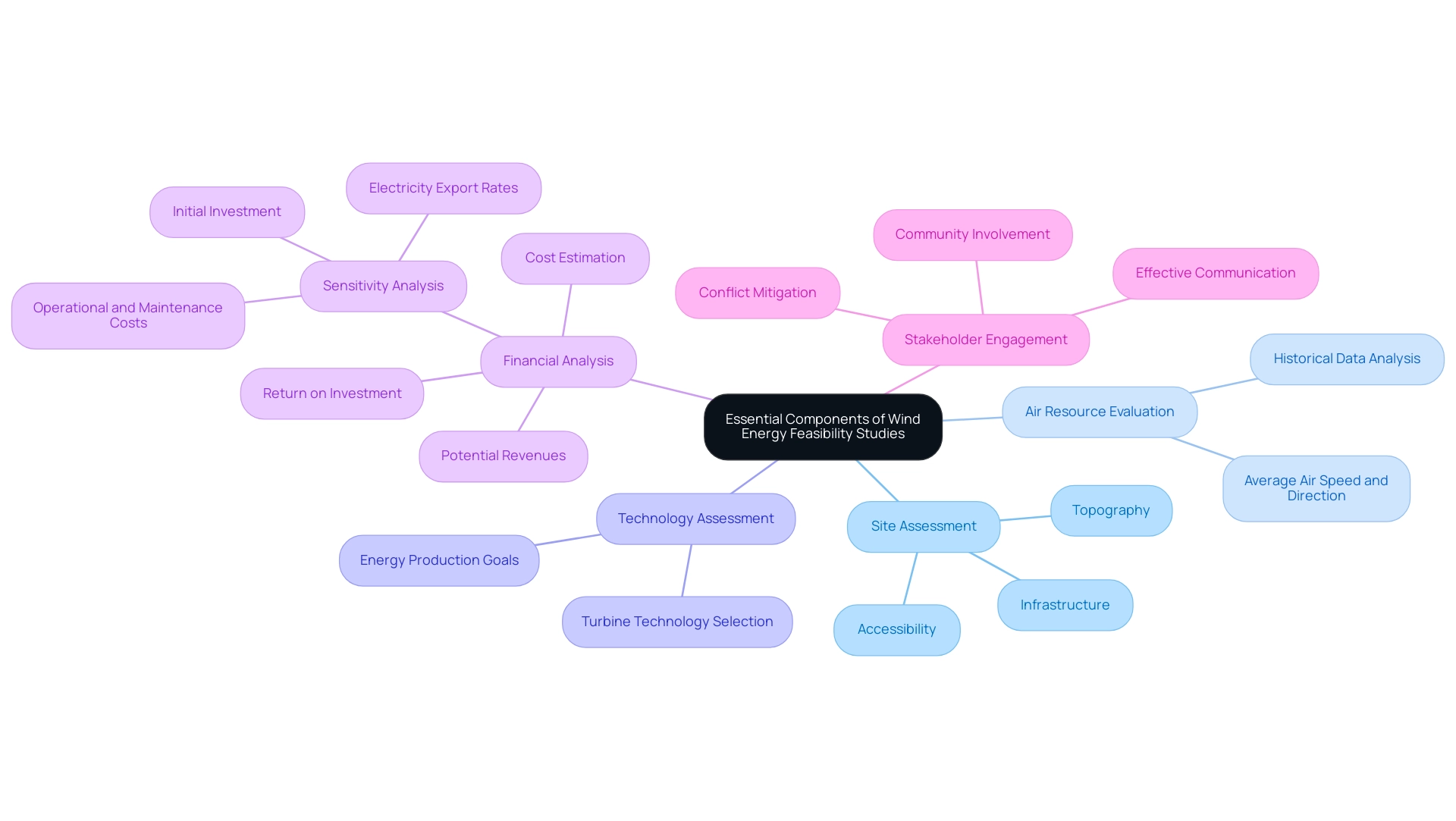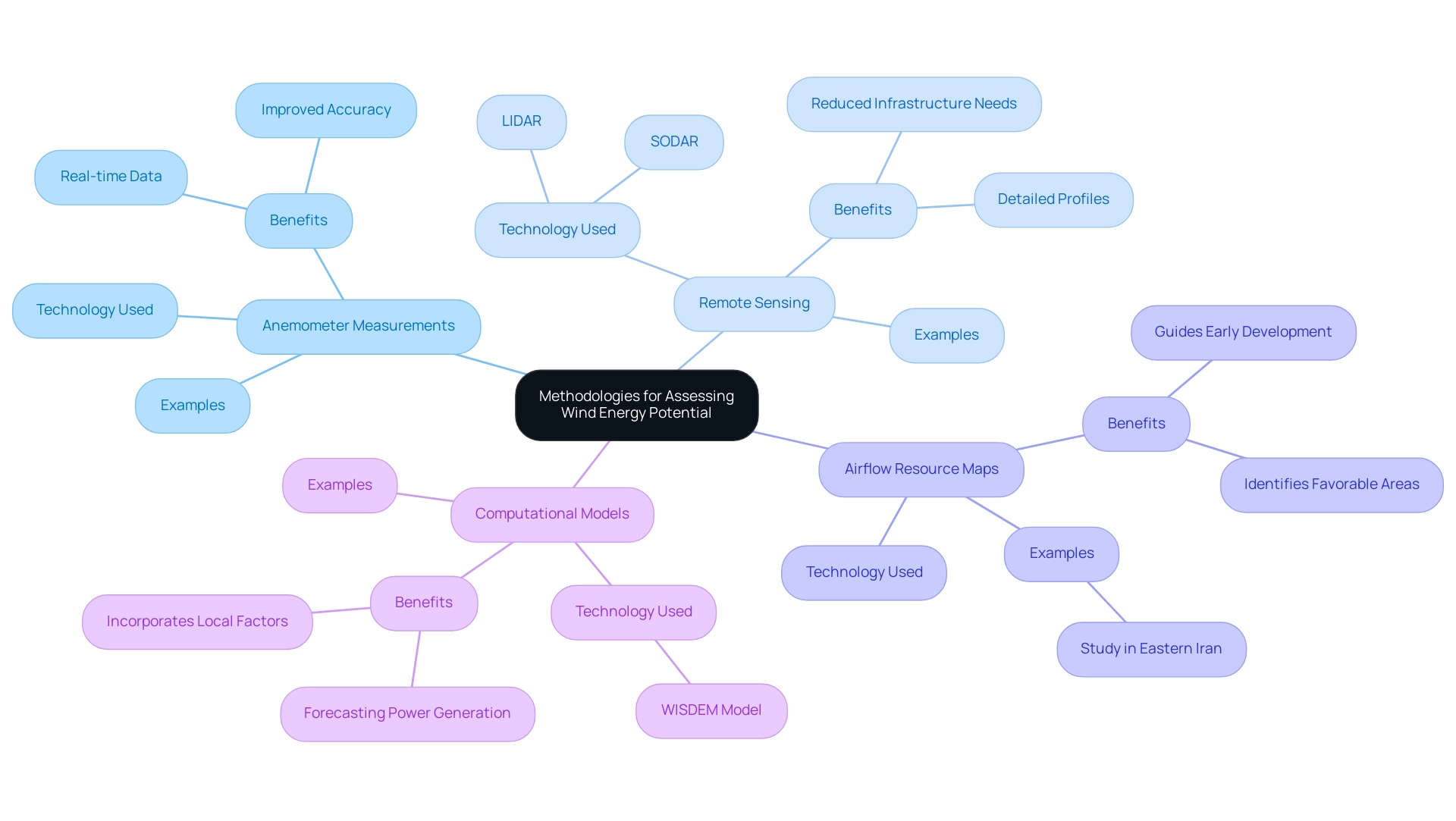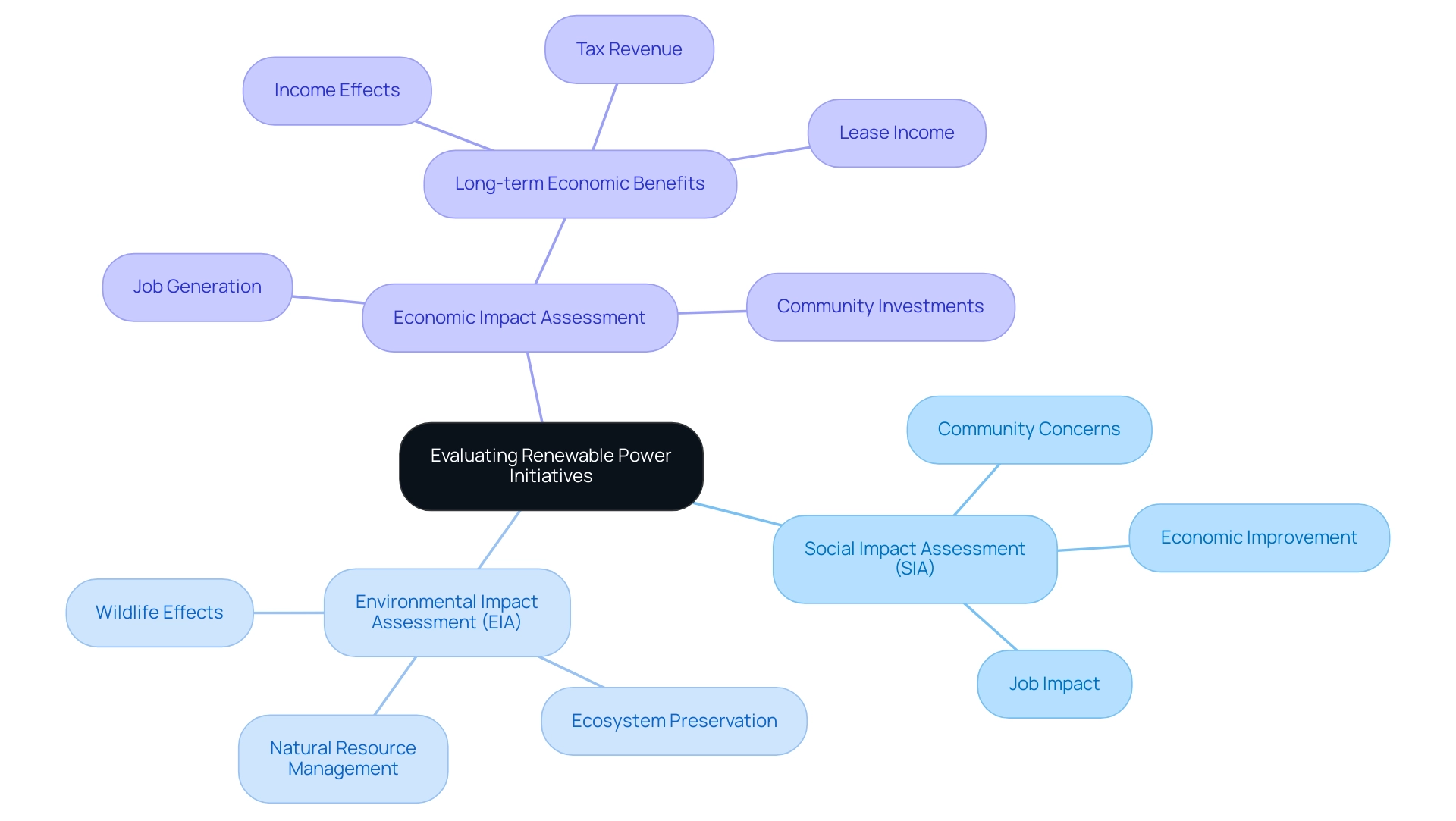Introduction
The rapid advancement of wind energy technology has positioned it as a cornerstone of sustainable development. As nations strive to reduce their carbon footprints, the importance of comprehensive feasibility studies for wind energy projects cannot be overstated. These studies serve as a critical foundation, encompassing essential components such as:
- Site assessments
- Wind resource evaluations
- Stakeholder engagement
By meticulously analyzing these elements, developers can navigate the complexities of regulatory landscapes, assess social and environmental impacts, and ultimately ensure the economic viability of their projects. This article delves into the intricate processes involved in wind energy feasibility studies, offering insights into methodologies, challenges, and future directions that can enhance the effectiveness and sustainability of wind energy initiatives worldwide.
Essential Components of Wind Energy Feasibility Studies
A thorough feasibility analysis for renewable power initiatives is essential for ensuring economic and operational success, comprising several critical components:
- Site Assessment: This involves a thorough evaluation of the land's physical characteristics, including its topography, accessibility, and existing infrastructure. Recent findings in Hong Kong indicate that hilltops and offshore islands present more favorable conditions for energy development compared to urban areas, reflecting the importance of geographical considerations. As emphasized in the case study 'Sensitivity Analysis of Wind Power Project,' careful consideration of geographic locations for turbine farms can significantly influence the project's payback time and overall economic benefits.
- Air Resource Evaluation: Analyzing historical data is fundamental in determining the average air speed and direction at the proposed site. This evaluation is instrumental in forecasting power production potential and making informed decisions about turbine placement.
- Technology Assessment: Identifying appropriate turbine technologies is crucial and should be based on the specific conditions of the location and the initiative's energy production goals. Understanding the technological landscape ensures that selected turbines can optimally harness available wind resources.
- Financial Analysis: Estimating costs, potential revenues, and return on investment is vital to assess the initiative's economic viability. A sensitivity analysis, such as those conducted using RETScreen software, reveals the intricate relationship between various input factors—like operational and maintenance costs, initial investment, and electricity export rates—and key economic indicators like internal rate of return (IRR) and net present value (NPV). This relationship highlights the need for a detailed financial analysis to ensure solid planning.
- Stakeholder Engagement: Involving local communities and stakeholders early in the process is critical for addressing concerns and gathering support. Effective communication fosters collaboration and helps mitigate potential conflicts, which are essential for conducting wind energy land feasibility studies, ensuring that all relevant factors are meticulously considered. As mentioned by Simon P. Philbin, a comprehensive feasibility study is essential for successful execution, ultimately resulting in sustainable and profitable solutions.

Methodologies for Assessing Wind Energy Potential
To effectively assess aerodynamic power potential, several methodologies are available for project developers:
- Anemometer Measurements: The installation of anemometers at different elevations allows for the gathering of real-time information on airspeed and direction over prolonged durations. Recent advancements in anemometer technology have significantly improved measurement accuracy, allowing for more reliable assessments of energy potential. This method provides essential insights into local atmospheric conditions, which are crucial for informed decision-making.
- Remote Sensing: Technologies such as LIDAR (Light Detection and Ranging) and SODAR (Sonic Detection and Ranging) facilitate the gathering of atmospheric profile data without the extensive infrastructure typically required for on-site equipment. These systems can create detailed vertical profiles of airspeed and direction, offering a broader and more precise understanding of the resource at a site.
- Airflow Resource Maps: Examining current airflow resource maps includes evaluating historical data to pinpoint areas with advantageous airflow conditions. These maps serve as a foundational tool in the early stages of project development, guiding developers toward areas that have shown consistent air movement patterns. For example, a recent study investigated the potential of air power across 22 areas in eastern Iran, emphasizing considerable opportunities for utilizing atmospheric resources.
- Computational Models: Utilizing advanced software simulations enables the forecasting of airflow patterns and power generation according to particular site conditions and turbine specifications. Such computational models can incorporate various factors, including local topography and meteorological data, to refine output yield forecasts. The WISDEM model illustrates this method, incorporating a complete array of turbine and facility models for thorough analysis, thus offering extensive insights into plant design and engineering.
By utilizing these techniques, developers can gain a detailed and refined understanding of the potential at their proposed locations. This thorough approach not only enhances the wind energy land feasibility studies but also informs the engineering and design processes. As the U.S. Department of Energy's National Renewable Resources Laboratory (NREL) emphasizes, the combined potential of offshore power resources underscores the need for precise evaluations, highlighting that this power source could potentially cover three times the annual electricity consumption of the United States.

Evaluating Social, Environmental, and Economic Impacts
Assessing the effects of renewable power initiatives is a complex process that necessitates thorough evaluation of diverse elements:
- Social Impact Assessment (SIA): This involves interacting with nearby communities to understand their concerns, advantages, and any possible disruptions linked to the initiative. Such involvement is essential, as research shows that renewable initiatives can improve regional economies, demonstrated by the favorable results noted in rural counties such as Sherman and Gilliam. Although these initiatives may not generate a significant number of permanent jobs, they have been shown to provide substantial tax revenue and lease income, which can greatly benefit communities.
- Environmental Impact Assessment (EIA): A comprehensive EIA is crucial to comprehend the effects of renewable initiatives on nearby wildlife, ecosystems, and natural resources. Recent assessments have highlighted the need for robust methodologies to evaluate these impacts, ensuring that biodiversity is preserved while harnessing renewable energy.
- Economic Impact Assessment: This assessment evaluates job generation, community investments, and the long-term economic advantages linked to renewable power initiatives. According to Brown et al. (2012), income effects from such developments can reach approximately $11,000 per capita, providing a significant boost to regional economies, especially in areas that have historically struggled with economic decline. Moreover, with community benefit mechanisms, renewable energy initiatives can fuel local investment as of Dec. 11, 2024, highlighting their economic potential.
The experiences of small rural counties such as Sherman County, Gilliam County, and Kenedy County illustrate these impacts. These counties, confronting economic difficulties from decreasing populations and restricted job prospects, have discovered new economic paths through energy development. While the initiatives may not generate numerous permanent jobs, they significantly contribute to the counties' economies through sustainable tax revenue and lease income.
By conducting comprehensive evaluations that encompass social, environmental, and economic impacts, developers can foster community support and ensure compliance with environmental regulations. This comprehensive method not only tackles possible issues but also places renewable initiatives as advantageous contributors to community growth, consistent with the favorable patterns noted in recent research.

Navigating Regulatory and Permitting Processes
Successfully navigating the regulatory and permitting processes for renewable power initiatives involves several critical steps:
- Identifying Regulatory Requirements: Conduct thorough research into the federal, state, and municipal regulations that govern wind energy development. Understanding these requirements is essential to ensure compliance and streamline the permitting process for wind energy land feasibility studies.
- Submitting Permit Applications: Prepare and submit applications for all necessary permits, such as environmental and construction permits. This step is crucial for establishing the initiative's legal framework and ensuring all aspects of the development are authorized.
- Public Consultation: Engage in public meetings and consultations to address community concerns and gather valuable input. Such engagement can foster goodwill and support within the community, as noted by local officials who seek to encourage and promote residency in areas like Sherman County, facilitating economic development and stability.
- Compliance Monitoring: Create a comprehensive plan for ongoing adherence to regulatory requirements throughout the lifecycle. This plan ensures that the initiative remains aligned with all legal obligations, thereby avoiding potential penalties or delays.
By following these steps, developers can effectively navigate the regulatory landscape of wind energy land feasibility studies, mitigate potential obstacles, and enhance community relations. Furthermore, renewable energy initiatives greatly aid regional economies; for example, last year, they produced over $2 billion in state and regional tax contributions and land-lease revenues, strengthening the financial advantages and consistent tax income created by such initiatives. Furthermore, the duration for power purchase agreements (PPAs) usually spans from 10 to 25 years, which is essential for financial planning in renewable initiatives.
Development charges can additionally support community services and infrastructure enhancements, further emphasizing the wider effect of renewable initiatives on surrounding communities. Moreover, communities can partner with developers of renewable resources to establish educational initiatives and scholarships, equipping local residents for positions in construction and maintenance of turbine systems, thereby enhancing the project's beneficial influence.
Addressing Limitations and Future Research Directions
Addressing the limitations in wind energy land feasibility studies is essential for driving progress in the sector. Key considerations include:
- Data Limitations: Accurate atmospheric data is critical, and recognizing potential gaps necessitates long-term monitoring to enhance the precision of assessments.
As demonstrated in the study on error and correlation analysis in energy generation, the introduction of a new variable for solar time (SolTime) provided a clearer understanding of diurnal weather cycles, revealing that modeled energy generation accuracy systematically declines in the evening but improves markedly after sunrise. This emphasizes a considerable difference, as renewable power generation potential is significantly greater during the day, while electricity usage trends reach their highest levels at night.
- Technological Advancements: Staying updated on new technologies is essential for enhancing assessments and operational efficiency of renewable sources.
Technological innovations have the potential to optimize data collection and enhance predictive modeling capabilities, which are pivotal for accurate wind energy land feasibility studies.
- Research Gaps: Identifying areas needing further investigation, such as the impacts of climate change on air currents, is critical. Continued investigation in this field can guide future initiatives and guarantee their flexibility to shifting ecological circumstances.
By focusing on these constraints and examining future research avenues, stakeholders can greatly aid in the advancement of renewable practices, ultimately ensuring the viability of forthcoming projects. As noted by Amos Ancell from Lawrence Berkeley National Laboratory, collaboration in refining meteorological data is key to enhancing these assessments, particularly in understanding how daily variations affect both wind generation and energy consumption.
Conclusion
Comprehensive feasibility studies are essential for the successful development of wind energy projects, serving as a foundation for sustainable practices in the sector. By conducting thorough site assessments and wind resource evaluations, developers can pinpoint optimal locations and accurately forecast energy production, ensuring both economic viability and operational success.
Utilizing advanced methodologies, such as anemometer measurements and remote sensing technologies, enhances data accuracy and informs critical design decisions. Moreover, evaluating the social, environmental, and economic impacts fosters community support and highlights the positive contributions of wind energy to local economies, particularly in rural regions.
Navigating the regulatory landscape is also crucial; understanding compliance requirements streamlines project implementation and strengthens community relations. Engaging stakeholders throughout the process promotes transparency and collaboration, further bolstering project success.
As the wind energy sector continues to evolve, addressing existing limitations and embracing future research directions will be vital. Ongoing technological advancements and long-term monitoring will enhance the precision of feasibility studies, enabling projects to adapt to changing conditions and demands.
In conclusion, the importance of comprehensive feasibility studies in wind energy development cannot be overstated. Through meticulous analysis and stakeholder collaboration, the wind energy sector can advance toward a sustainable future, solidifying its role as a key contributor to global renewable energy initiatives.
Frequently Asked Questions
Why is a thorough feasibility analysis important for renewable power initiatives?
A thorough feasibility analysis is essential for ensuring the economic and operational success of renewable power initiatives by evaluating critical components such as site assessment, air resource evaluation, technology assessment, financial analysis, and stakeholder engagement.
What does site assessment involve in the feasibility analysis?
Site assessment involves evaluating the land's physical characteristics, including topography, accessibility, and existing infrastructure. It is crucial to consider geographical factors, as certain locations, like hilltops and offshore islands, may present more favorable conditions for energy development compared to urban areas.
How is air resource evaluation conducted?
Air resource evaluation involves analyzing historical data to determine the average air speed and direction at the proposed site. This evaluation is vital for forecasting power production potential and making informed decisions about turbine placement.
What is the significance of technology assessment in renewable energy projects?
Technology assessment is crucial for identifying appropriate turbine technologies based on the specific conditions of the location and the energy production goals of the initiative. This ensures that selected turbines can optimally harness available wind resources.
What does financial analysis entail in the feasibility study?
Financial analysis involves estimating costs, potential revenues, and return on investment to assess the initiative's economic viability. It includes conducting sensitivity analyses to understand the relationship between various input factors and key economic indicators like internal rate of return (IRR) and net present value (NPV).
Why is stakeholder engagement important in renewable energy projects?
Stakeholder engagement is critical for involving local communities and stakeholders early in the process to address concerns and gather support. Effective communication fosters collaboration and helps mitigate potential conflicts, which are essential for successful feasibility studies.
What methodologies are available for assessing aerodynamic power potential?
Several methodologies include: 1. Anemometer Measurements: Gathering real-time airspeed and direction data using anemometers. 2. Remote Sensing: Using technologies like LIDAR and SODAR to gather atmospheric profile data without extensive infrastructure. 3. Airflow Resource Maps: Evaluating historical data to identify areas with favorable airflow conditions. 4. Computational Models: Utilizing advanced software simulations to forecast airflow patterns and power generation.
How do these methodologies benefit project developers?
These methodologies provide developers with a detailed understanding of the potential at proposed locations, enhancing the feasibility studies and informing the engineering and design processes for wind energy projects.
List of Sources
- Essential Components of Wind Energy Feasibility Studies
- Techno-Economic Analysis and Modelling of the Feasibility of Wind Energy in Kuwait (https://mdpi.com/2571-8797/4/1/2)
- Statistical analysis of wind characteristics and wind energy potential in Hong Kong (https://sciencedirect.com/science/article/abs/pii/S019689041500535X)
- Methodologies for Assessing Wind Energy Potential
- Assessment of wind energy potential and economic evaluation of four wind turbine models for the east of Iran (https://sciencedirect.com/science/article/pii/S2405844021013372)
- Wind energy potential assessment based on wind speed, its direction and power data - PMC (https://pmc.ncbi.nlm.nih.gov/articles/PMC8377008)
- Wind Resource Assessment and Characterization (https://energy.gov/eere/wind/wind-resource-assessment-and-characterization)
- Wind Data and Tools | Wind Research | NREL (https://nrel.gov/wind/data-tools.html)
- Evaluating Social, Environmental, and Economic Impacts
- National Survey of Attitudes of Wind Power Project Neighbors | Energy Markets & Policy (https://emp.lbl.gov/projects/wind-neighbor-survey)
- sciencedirect.com (https://sciencedirect.com/science/article/pii/S2772655X24000077)
- WINDExchange: Concerns about Wind Energy’s Impact on Communities (https://windexchange.energy.gov/projects/community)
- Measuring the impacts of wind energy projects on U.S. rural counties’ community services and cost of living (https://sciencedirect.com/science/article/abs/pii/S0301421521001488)
- Navigating Regulatory and Permitting Processes
- windexchange.energy.gov (https://windexchange.energy.gov/economic-development-guide)
- Wind Power Facts and Statistics | ACP (https://cleanpower.org/facts/wind-power)
- Addressing Limitations and Future Research Directions
- Limitations of reanalysis data for wind power applications (https://onlinelibrary.wiley.com/doi/full/10.1002/we.2759)
- Investigation and statistical analysis of electrical energy production from the wind farm (https://pubs.aip.org/aip/adv/article/13/6/065010/2894867/Investigation-and-statistical-analysis-of)
- Wind Energy Factsheet (https://css.umich.edu/publications/factsheets/energy/wind-energy-factsheet)




